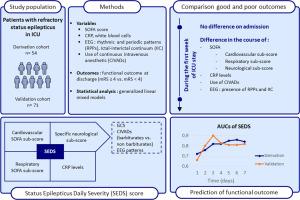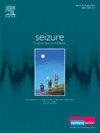SEDS评分:ICU中监测难治性SE患者的每日严重程度评分
IF 2.8
3区 医学
Q2 CLINICAL NEUROLOGY
引用次数: 0
摘要
难治性癫痫持续状态(RSE)通常需要入住重症监护病房(ICU)。现有的特定预后评分不能解释难治性、生命支持依赖性或相关合并症,通常不能准确预测RSE的预后。我们的目标是制定一个每日严重程度评分,就像现有的危重疾病评分一样,跟踪患者在ICU的发展轨迹,并预测他们出院时的结果。方法:对2015年1月至2023年5月期间两家三级护理中心ICU收治的RSE发作的两个独立前瞻性队列(推导和验证队列)进行回顾性观察研究。采用Mann-Whitney检验和广义线性混合模型,收集不良和良好结局组(改良Rankin量表(mRS)≥4或<;4)在入院时和ICU住院第一周期间的顺序器官衰竭评估(SOFA)评分、附加神经学、脑电图、治疗相关和生物学变量,并进行比较。基于显著的单变量,我们导出了SE每日严重程度(SEDS)评分,并使用受试者工作特征曲线下面积(AUC)测量其对功能结果的预测性能。结果推导队列和验证队列分别纳入54例和71例。在衍生队列中,在ICU入院时未发现差异。SOFA评分在第一周的过程中存在差异(p <;0.001),尤其是心血管和呼吸成分c反应蛋白(p <;0.001), se相关变量和EEG变量。SEDS评分包括SOFA评分中的心血管和呼吸成分、CRP水平、GCS、脑电图模式和连续静脉麻醉药物的使用,其auc值优于单独考虑的各成分,衍生组的auc值为0.70 ~ 0.83,验证组的auc值为0.72 ~ 0.84。结论在ICU入院时现有评分无差异的情况下,SEDS评分在ICU住院第一周内达到AUC >;0.70,表明在预测出院时预后不良方面表现良好。本文章由计算机程序翻译,如有差异,请以英文原文为准。

The SEDS score: A daily severity score for monitoring patients with refractory SE in the ICU
Introduction
Refractory status epilepticus (RSE) usually requires admission in an intensive care unit (ICU). Available specific prognostic scores for SE do not account for refractoriness, life support dependency, or related comorbidities, and usually fail to accurately predict outcome in RSE. Our goal was to develop a daily severity score, like existing scores used for critical illness, to follow patients' trajectory in the ICU and predict their outcome at discharge.
Methods
Retrospective observational study of two independent prospectively identified cohorts (derivation and validations cohorts) of RSE episodes admitted in the ICU of two tertiary-care centers, between January 2015 and May 2023. The sequential organ failure assessment (SOFA) score, additional neurological, EEG, treatment-related and biological variables were collected and compared between poor and good outcome groups (modified Rankin Scale (mRS) ≥ 4 or <4), on admission and during the first week of ICU stay, using Mann-Whitney tests and generalized linear mixed models. Based on significant univariate variables, we derived the SE daily severity (SEDS) score and measured its predictive performance for functional outcome using the area under the receiver operating characteristic curve (AUC).
Results
54 episodes and 71 episodes were included in derivation and validation cohorts, respectively. In the derivation cohort, no difference was found at ICU admission. The course of the SOFA score over the first week differed (p < 0.001) between groups, especially their cardiovascular and respiratory components, C-reactive protein (p < 0.001), SE-related and EEG variables. The SEDS score, which includes cardiovascular and respiratory components of SOFA score, CRP levels, GCS, EEG patterns and the use of continuous intravenous anesthetic drugs, had better AUCs than each components considered separately, ranging from 0.70 to 0.83 in the derivation cohort from 0.72 to 0.84 in the validation cohort.
Conclusion
In the absence of differences in existing scores on ICU admission, the SEDS score achieved an AUC >0.70 throughout the first week of ICU stay, indicating good performance to predict poor outcome at hospital discharge.
求助全文
通过发布文献求助,成功后即可免费获取论文全文。
去求助
来源期刊

Seizure-European Journal of Epilepsy
医学-临床神经学
CiteScore
5.60
自引率
6.70%
发文量
231
审稿时长
34 days
期刊介绍:
Seizure - European Journal of Epilepsy is an international journal owned by Epilepsy Action (the largest member led epilepsy organisation in the UK). It provides a forum for papers on all topics related to epilepsy and seizure disorders.
 求助内容:
求助内容: 应助结果提醒方式:
应助结果提醒方式:


